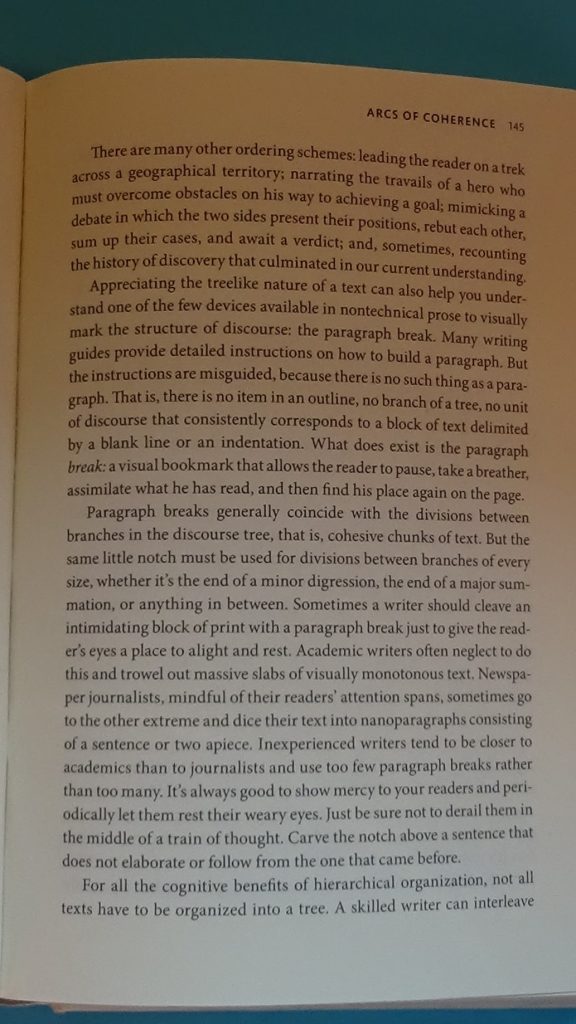This morning I’m going to be rewriting the page I’ve devoted to the introduction of a standard 8000-word paper in the social sciences. Ideally, the introduction occupies the first three minutes of the reader’s attention, during which it situates the paper’s conclusion in a shared science and a familiar world. It should draw the reader in, give the reader a place, and get the reader thinking. As a mnemonic device, one that is perhaps a bit too cute, we can say that it should evoke a world, invoke a science, and propose a thought. The easiest way to think of these tasks is to give each of them a paragraph, which is what I will be describing on the permanent page. In this blog post I want to reduce the problem a bit further, imagining how it can all be done in a single a paragraph at the beginning of a much shorter 1000-word essay.
Instead of giving yourself a whole paragraph to describe the world you share with the reader, try doing it in only two sentences. Then, as seamlessly as possible, go on to write another two sentences about the science that you and your reader apply to the problem of understanding this world a little better. Finally, write two sentences that state your conclusion and the basis on which you’ve drawn it. Let me show you what I mean.
Effective emergency response requires, not just competent team members, but strong team cohesion. Even if everyone does their job perfectly, tragedy can strike if they are not mindful of how their actions both depend upon a collective effort and make a contribution to it.
In these two sentences, a world of shared concerned is evoked in the mind of the reader. The reader is expected to care about the effectiveness of emergency response teams, and is reminded about the importance of social cohesion. While there’s nothing particularly controversial going on in these sentences (who would argue against this way of putting it?) an interest is stimulated by the dramatic possibility of a tragic outcome. Crucially, the reader (I hope) gets the sense that I know what I’m talking about, even if the space limitations (so far) haven’t allowed me to say very much.
We can now go on to the science that will frame our analysis.
Organizational sensemaking has therefore been a longstanding focus of research into high reliability organizations (Weick & Sutcliffe, 2011). In his seminal study of the Mann Gulch disaster, for example, Karl Weick (1993) found that the smokejumpers panicked as a result of a sudden loss of social structure, producing what he called a “cosmology episode” during which no one knew what was going on or what to do.
Notice here how the relatively ordinary notions of “team cohesion” and “collective” responsibilities are reframed in the strictly theoretical language of sensemaking, invoking “social structure” and “cosmology episodes” as these terms are defined in agenda-setting past research. Notice that references are here introduced to situate this paper in a larger conversation with other scholars. All that’s left to do is to introduce my contribution to the discussion:
I here want to challenge this conclusion by way of a close rereading of Weick’s sole source of data for his analysis, viz. Norman Maclean’s book Young Men and Fire (1992). It turns out that, not only did the men not panic, they responded rationally to a situation that simply got out of control because of what Maclean describes as a “conflagration” of forces.
There should be no doubt now about why I’m writing this essay. I’ve started with an important activity in the human world (emergency response) and a discipline devoted to understanding how this activity can be carried out more effectively (sensemaking scholarship). I’ve then introduced a thesis that challenges our currently held views about a particular conception of “social structure” and laid out the basis on which I’m going to make my argument. Here’s how looks when we put it all together:
Effective emergency response requires, not just competent team members, but strong team cohesion. Even if everyone does their job perfectly, tragedy can strike if they are not mindful of how their actions both depend upon a collective effort and make a contribution to it. Organizational sensemaking has therefore been a longstanding focus of research into high reliability organizations (Weick & Sutcliffe, 2011). In his seminal study of the Mann Gulch disaster, for example, Karl Weick (1993) found that the smokejumpers panicked as a result of a sudden loss of social structure, producing what he called a “cosmology episode” during which no one knew what was going on or what to do. I here want to challenge this conclusion by way of a close rereading of Weick’s sole source of data for his analysis, viz. Norman Maclean’s book Young Men and Fire (1992). It turns out that, not only did the men not panic, they responded rationally to a situation that simply got out of control because of what Maclean describes as a “conflagration” of forces.
There are six sentences here and 174 words. This gives me room for a sentence more if I want, and it can certainly be rewritten to make the transitions — from evocation, to invocation, to proposition — more subtle. But I hope this can serve as a sort of a “proof of concept”.
